Grevillea ground covers are a great way to add colour and drama to your borders without the height and stature of the more familiar varieties. As well as providing an excellent source of nectar for pollinators, they help to support native birds and wildlife, and can even control weeds and reduce maintenance around the garden.
While most ground cover grevilleas are wide-spreading shrubs, typically reaching 4-5m across, they can be easily tamped and controlled for more compact displays. Follow our guide for more information on growing and caring for ground cover grevilleas.
More...
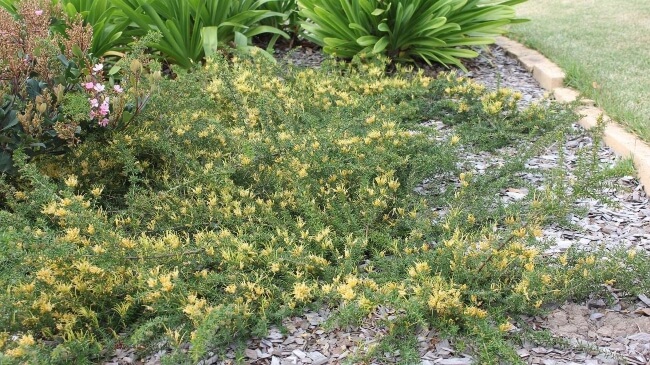
Source: Alpine Nurseries
Family: | Proteaceae |
|---|---|
Genus: | Grevillea |
Species: | Various |
Origin: | Australian natives |
Common Names: | Grevillea, Spider Flowers |
Location: | Outdoor |
Type: | Shrub |
Growth: | 0.5m tall, 5m wide (depending on variety) |
Foliage Colour: | Green |
Flower Colour: | Orange |
Flowering: | Winter to Spring |
Edible Parts: | None |
Maintenance level: | Low |
Poisonous for pets: | Non-toxic to cats and dogs |
Choosing the Best Ground Cover Grevillea for Your Garden
Grevilleas are pretty low-maintenance shrubs, providing beautiful foliage and a long flowering season in any Australian garden. They are also, as with all grevilleas, very varied in their form, habit, and nature.
Some ground cover grevilleas are simply dwarf varieties of taller shrubs, with needle-like foliage, or spear shaped leaves, while others are distinctly succulent, and thrive on poor soil.
Choosing the right ground cover grevilleas for your garden will depend almost entirely on your soil conditions, so we’ve put together a simple guide here.
Grevillea Ground Cover Varieties for Open Spaces
Grevillea ‘Poorinda Royal Mantle’
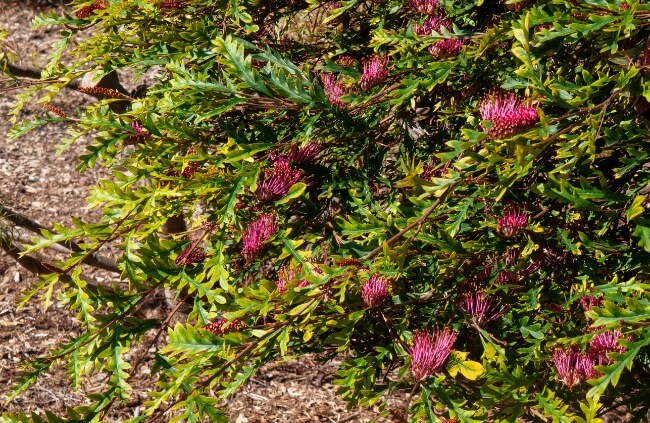
The most popular ground cover grevillea is Grevillea ‘Poorinda Royal Mantle’, with its long, spear-shaped leaves, and generous covering of long, dense, crimson flowers. It’s a gorgeous prostrate shrub, which flows across flat ground, but looks at its best draping over walls, and softening slopes.
Grevillea obtusifolia ‘Gin Gin Gem’

Source: Domus Nursery
One of the best and toughest grevilleas for open spaces, which can withstand harsh winds, and even frosts, is Grevillea obtusifolia ‘Gin Gin Gem’. The incredibly low-growing grevillea is one of the best weed-suppressing ground cover plants there is, and its soft needle-like foliage can be used brilliantly to fill empty beds quickly, or trail down over terracing.
Ground Cover Grevilleas for Loamy Soils
Grevillea ‘Bronze Rambler’
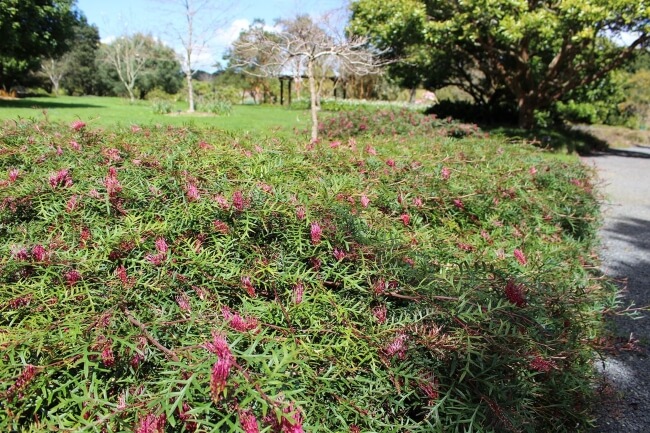
Source: Auckland Botanic Gardens
On richer soils, or soils with slightly slower drainage than most, Grevillea ‘Bronze Rambler’ is a perfect choice. Its deeply lobed leaves add interest and texture at the front of borders, or can be used beautifully as a low-growing space divider.
Grevillea ‘Bronze Rambler’ is generally grown for foliage rather than flower, but still offers plenty for wildlife in the way of habitat and nectar.
Grevillea ‘Aussie Crawl’
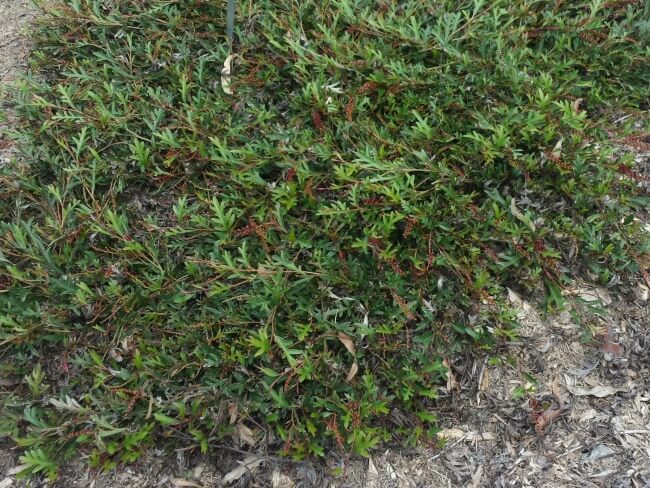
Source: Gardening With Angus
One other notable grevillea for ground cover on loamy soils is Grevillea ‘Aussie Crawl’, with wider, brighter, greener foliage, and more upright stamens which make for more dramatic flowers. It thrives in a variety of conditions, and benefits from a spring mulch of deciduous wood chip.


Get Your Free Guide:
Master Growing Australian Natives eBook
A Must Have Complete Guide for Every Australian Garden
Get Your Free Guide:
Master Growing Australian Natives eBook
A Must Have Complete Guide for Every Australian Garden
Ground Cover Grevilleas for Free-Draining or Poor Soils
There are two stand-out Grevillieas for poor, gravelly soil, which hold moisture in their fleshy foliage and produce plentiful, but compact flowers.
Grevillea lanigera
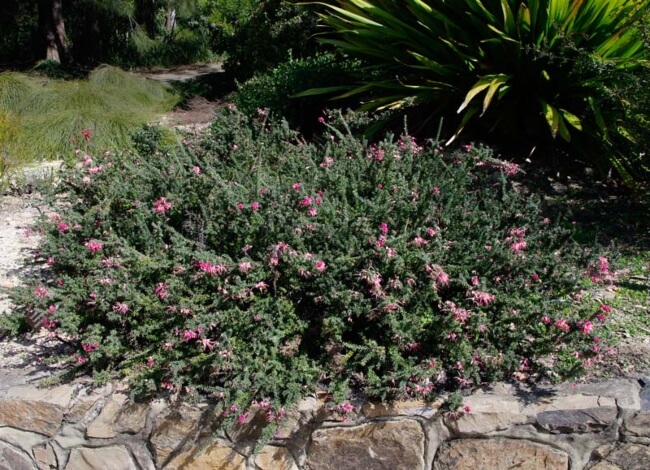
Source: Provincial Plants & Landscapes
Grevillea lanigera, the Woolly Grevillea, is the most popular of these drainage-loving grevilleas, which can grow in compact spaces, and typically reaches around 1.5m at most. It’s dense, but structural stems create a gorgeous mesh of colour all year round.
Grevillea lanigera ‘Mt Tamboritha’
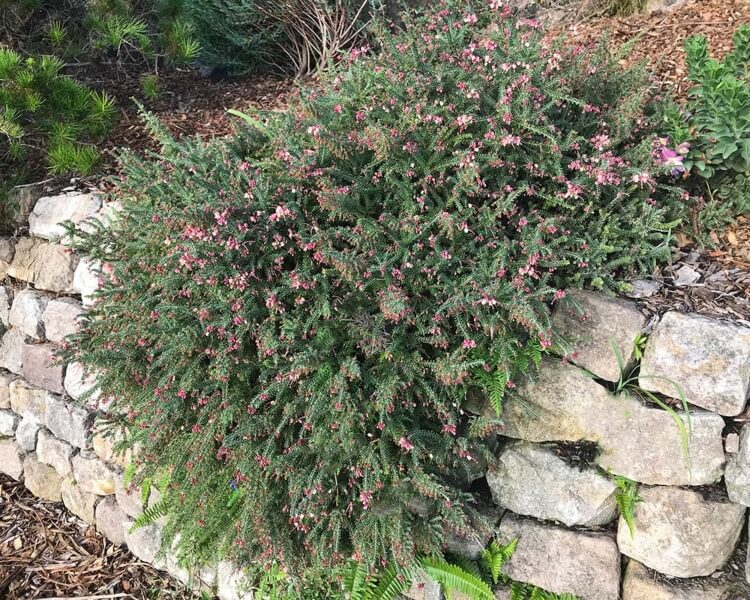
Source: GardensOnline
Grevillea lanigera ‘Mt Tamboritha’ is a more vigorous cultivar of the same species, with tighter foliage, more even stems, and a beautifully delicate flower, which is much more prolific if the tips of stems are pinched out after flowering, as it flowers at the tips of new growth.
How to Grow Ground Cover Grevilleas
Growing grevillea ground cover plants is really quite simple. All they need is good drainage, balanced nutrients, and (if you’re unsure) a soil test to check phosphorus levels in your garden before planting.
Grevillea Ground Cover Soil Preparation
Before planting any grevillea, but particularly ground cover grevilleas, test your soil for phosphorus. There will undoubtedly be phosphorus present in your soil, but it should be locked into the soil, and inaccessible to roots.
Phosphorus levels should be reasonably low, and the pH should be near neutral. If either measurement is too acidic or too rich, adjust the soil accordingly with feeds, soil improvers, compost, or soil additives.
The most basic thing though, is ensuring good drainage. Grevilleas can grow on quite poor soil, but flower best on nitrogen rich loam, so it’s a good idea to add an organic soil improver to your plot before planting.
Choosing the Right Location for Grevillea Ground Cover
Ground cover grevilleas are more resilient to wind damage than taller types, simply because they are tighter to the ground, but some are particularly well suited, and those with silvery foliage are ideal for exposed conditions. In all cases, grevilleas like warm, sunny spots.
Planting and Spacing Grevillea Ground Cover
Grevillea ground cover plants are easy to plant. Just dig out a hole that’s twice the depth and twice the width of the existing root ball, add some soil improver to the soil you dug out, and plant it so the base of the stem is level with the soil.
Space ground cover grevilleas about 1 m apart. They will quickly fill in the gaps and will learn to cope with being intermingled.
How to Care for Ground Cover Grevilleas
Grevilleas can cope in really quite harsh conditions, but are fundamentally ornamental plants when we use them in our gardens, so rather than leaving them to fend for themselves, and survive, help them to thrive with an annual mulch of part-rotted bark, or leaf mould.
Avoid mulching right up the stems as this can cause winter rot at the base of the plant. Feed them in spring with organic mulches like this, or slow release native plant fertilisers with low phosphorus content.
Pruning Ground Cover Grevilleas
Ground cover grevilleas, by their nature, do not need pruning. They are spreading, low-growing, ground cover plants, and their foliage will always take its best form when left to its own devices.
However, there are some, particularly the more succulent leaved types of grevillea, which flower best on the new tips of new growth. By neatly pinching out growing tips after flowering, you can promote more flowers next time.
Propagating Ground Cover Grevillea
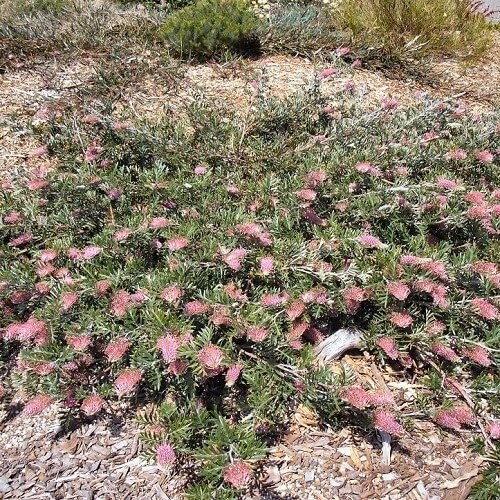
Source: Greenleaf Nurseries
Ground cover grevilleas can be propagated from seeds or cuttings, and some types will naturally root from the stems, creating natural points to divide plants. For more information on propagating grevilleas, check out our article on how to grow grevilleas including its different varieties.
Ground Cover Grevillea Pests and Diseases
Ground cover grevilleas can suffer more widely than taller species from fungal problems due to higher humidity in their dense mesh of foliage and stems, so do need to be planted on well-drained soil and protected from damp conditions, particularly through winter, where moisture evaporates far slower.
Keep an eye out for patches of yellowing foliage or brown sections, which can be cut out to prevent the spread of infection problems that may be causing them. The most common problem is sooty mould (black, dusty sections, usually forming at leaf junctions). Removing sections of ground-cover grevillea will leave holes in the plant, but they will quickly fill in with new, healthy, growth.
Yellow foliage, or dropping leaves on ground cover grevilleas is most commonly caused by phosphorus toxicity, or phosphorus burn when too much of that particular nutrient is present in fertilisers.
Occasionally, the same symptoms are caused by overly acidifying the soil, which can make pre-existing phosphorus accessible to the plant. This can be remedied by adding gypsum, or simply flushing the soil with generous watering for a few days.
Ground Cover Grevillea Frequently Asked Questions
Do grevilleas have invasive roots?
Grevillea roots are not invasive. They are shallow-rooted native plants that will not damage walls, foundations, or pipe work.
How big do ground cover grevilleas get?
Ground cover grevilleas can be as tall or wide as you need them to be, but the term most commonly refers to those varieties that spread between 2 and 5 m wide, and won’t grow taller than 50 cm tall.
How long do grevilleas live?
Grevilleas don’t have a set lifespan, they will live for as long as they are healthy. In gardens, this is usually longer than in nature, meaning grevilleas are likely to outlive their gardeners by quite some way.
What is the best place to plant a ground cover grevillea?
The best place to plant ground cover grevilleas is anywhere that shows off their prostrate form. Overhanging walls or grown down terraces are the most effective ways to display their trailing habit.
How hardy are ground cover grevilleas?
Ground cover grevilleas are frost-hardy, so can be grown in most climates, and hold their foliage through winter easier. If there is a particularly cold winter predicted, it’s important not to prune grevilleas after early summer, as new growth can be damaged by frost. The older woody growth is rarely damaged by frost.
Wrapping Up Our Guide to Using Grevillea Ground Covers
Ground cover plants, in general, are a clever solution to a lot of different problems. Whether you’re trying to make a new garden look established, or you’re just trying to control problem weeds, ground cover grevilleas offer a beautiful solution to an age-old question.
Finding the right place to plant them is easy too. Just give your ground cover grevilleas full sun, good drainage, and a generous organic mulch, and you’ll make sure you’ve got the best display possible year, after year, after year.
Published on September 8, 2023 by Gary Clarke
Last Updated on September 20, 2024




